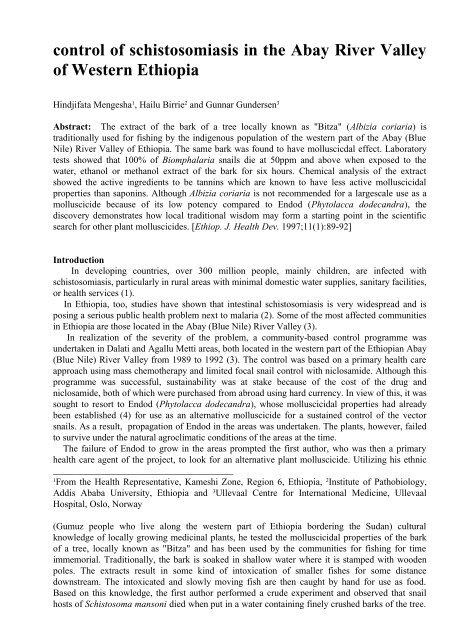Original article - Ethiopian Review
Original article - Ethiopian Review
Original article - Ethiopian Review
- No tags were found...
Create successful ePaper yourself
Turn your PDF publications into a flip-book with our unique Google optimized e-Paper software.
control of schistosomiasis in the Abay River Valleyof Western EthiopiaHindjifata Mengesha 1 , Hailu Birrie 2 and Gunnar Gundersen 3Abstract: The extract of the bark of a tree locally known as "Bitza" (Albizia coriaria) istraditionally used for fishing by the indigenous population of the western part of the Abay (BlueNile) River Valley of Ethiopia. The same bark was found to have molluscicdal effect. Laboratorytests showed that 100% of Biomphalaria snails die at 50ppm and above when exposed to thewater, ethanol or methanol extract of the bark for six hours. Chemical analysis of the extractshowed the active ingredients to be tannins which are known to have less active molluscicidalproperties than saponins. Although Albizia coriaria is not recommended for a largescale use as amolluscicide because of its low potency compared to Endod (Phytolacca dodecandra), thediscovery demonstrates how local traditional wisdom may form a starting point in the scientificsearch for other plant molluscicides. [Ethiop. J. Health Dev. 1997;11(1):89-92]IntroductionIn developing countries, over 300 million people, mainly children, are infected withschistosomiasis, particularly in rural areas with minimal domestic water supplies, sanitary facilities,or health services (1).In Ethiopia, too, studies have shown that intestinal schistosomiasis is very widespread and isposing a serious public health problem next to malaria (2). Some of the most affected communitiesin Ethiopia are those located in the Abay (Blue Nile) River Valley (3).In realization of the severity of the problem, a community-based control programme wasundertaken in Dalati and Agallu Metti areas, both located in the western part of the <strong>Ethiopian</strong> Abay(Blue Nile) River Valley from 1989 to 1992 (3). The control was based on a primary health careapproach using mass chemotherapy and limited focal snail control with niclosamide. Although thisprogramme was successful, sustainability was at stake because of the cost of the drug andniclosamide, both of which were purchased from abroad using hard currency. In view of this, it wassought to resort to Endod (Phytolacca dodecandra), whose molluscicidal properties had alreadybeen established (4) for use as an alternative molluscicide for a sustained control of the vectorsnails. As a result, propagation of Endod in the areas was undertaken. The plants, however, failedto survive under the natural agroclimatic conditions of the areas at the time.The failure of Endod to grow in the areas prompted the first author, who was then a primaryhealth care agent of the project, to look for an alternative plant molluscicide. Utilizing his ethnic______________________________________1From the Health Representative, Kameshi Zone, Region 6, Ethiopia, 2 Institute of Pathobiology,Addis Ababa University, Ethiopia and 3 Ullevaal Centre for International Medicine, UllevaalHospital, Oslo, Norway(Gumuz people who live along the western part of Ethiopia bordering the Sudan) culturalknowledge of locally growing medicinal plants, he tested the molluscicidal properties of the barkof a tree, locally known as "Bitza" and has been used by the communities for fishing for timeimmemorial. Traditionally, the bark is soaked in shallow water where it is stamped with woodenpoles. The extracts result in some kind of intoxication of smaller fishes for some distancedownstream. The intoxicated and slowly moving fish are then caught by hand for use as food.Based on this knowledge, the first author performed a crude experiment and observed that snailhosts of Schistosoma mansoni died when put in a water containing finely crushed barks of the tree.




![to read the full report [pdf, Amharic] - Ethiopian Review](https://img.yumpu.com/52737829/1/190x245/to-read-the-full-report-pdf-amharic-ethiopian-review.jpg?quality=85)











